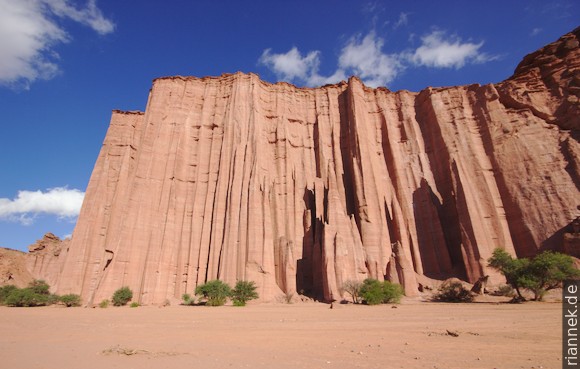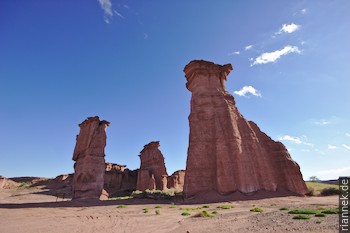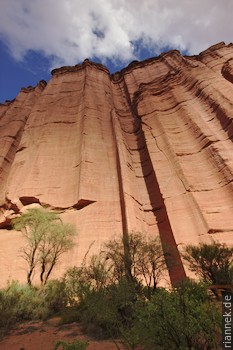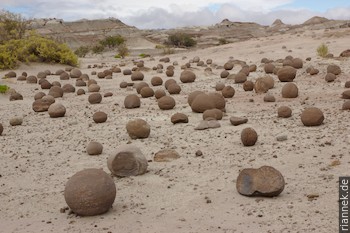
Approximately halfway between the towns of San Juan and La Rioja, the Talampaya National Park and (separated by the provincial border) the Ischigualasto Nature Reserve (“Valle de la Luna”) are located right next to each other. Talampaya is particularly rich in postcard views of bizarre rock formations, especially a gorge cutting through the sandstone and some columnar and mushroom-shaped rocks. The odd “mushroom” can also be found in Ischigualasto, but this reserve is famous for its geology for another reason: the oldest dinosaurs in the world have been found here, along with other important fossils.

We park at the Visitor Centre of Talampaya, as the interior of the park can only be entered on a guided tour. The standard route takes about 3 h and leads in a minibus through the Cañon de Talampaya and on the other side along high rock walls (“Catedral”) to three particularly high “mushrooms” (one is called “El Monje”). On the way, you get out of the car several times for short walks and see, among other things, old petroglyphs carved into the rock. The vertical “chimneys” in the rock walls in the gorge are impressive, they were incised by water. A river only flows through the gorge after heavy rainfall, but there is groundwater at a shallow depth, so there are many trees here in the middle of the desert. A beautiful contrast to the red conglomerate/sandstone rocks (Talampaya Formation and Tarjados Formation above, both Lower Triassic).

A rift system developed in the region from the end of the Permian, into which sediments were deposited in the Triassic. In the Early Triassic, these were initially mainly alluvial fans, later there were rivers and salt lakes. At this time, strange animals were already running through the area, but dinosaurs did not exist until the Carnian in the Late Triassic.

The corresponding rocks are mainly exposed in Ischigualasto. It was a landscape with rivers and many lakes, through which many strange reptiles trudged — not only the first dinos. The latter were still outnumbered and still quite small. The Herrerasaurus barely reaches my hip, the Eoraptor only up to my knee (both were carnivorous Saurischia). Pisanosaurus (a herbivorous Ornithischia) was even slightly smaller. Other reptiles of their time were more like what most people imagine a dinosaur to be: In particular, the primordial crocodile Saurosuchus galilei, which grew up to 9 m long. Most common, however, were two other strange animals. The reconstructions of Exaeretodon look like a cross between a wild boar and a hyena, just under 2 m tall. It is a cynodont (“dog-tooth”), to which the later mammals also belong. The Hyperodapedon, on the other hand, about 1 m long, looked like a giant salamander with a single bucktooth on its upper jaw, but it was a reptile.
Original fossils, reconstructed skeletons and life-size reconstructed models are available both at the reserve’s Visitor Centre and at the very worthwhile Natural History Museum in San Juan, where you can even watch the palaeolontologists at work.

The Ischigualasto Nature Reserve can also only be visited with a guide, but here you drive in your own car in a convoy, the guide sits in the first car (this takes about 3 h). You see mostly undulating eroded light grey mudstones, but also a few mushroom-shaped rock formations (much smaller than in Talampaya) like El Hongo and El Submarino (which once looked like a submarine, unfortunately a large part has broken off). Interesting is Cancha de Bochas (“bowling lane”), where countless black balls (concretions) lie around on the ground. Partially exposed fossils can also be seen in situ under a protective structure.

Read on
Valles Calchaquíes (with Quebrada de Cafayate, Cachi and Los Cardones)
Quebrada de Humahuaca
At the toe of Aconcagua
Patagonia
The Formation of Mountains